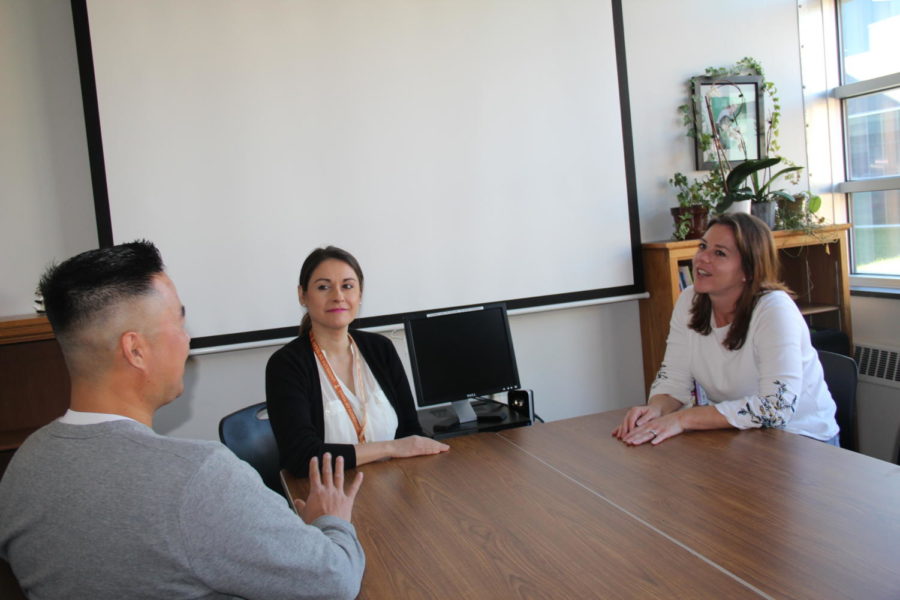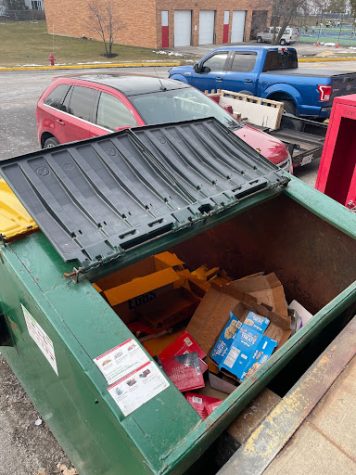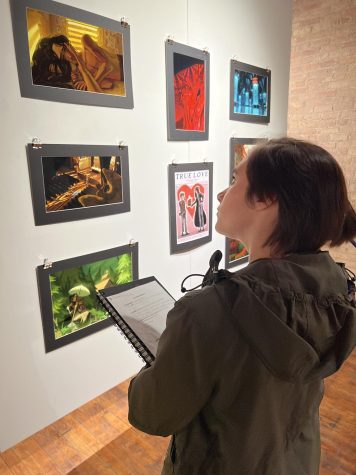What can the counselors do for you?
On Oct. 23, Counselors Samantha Smigielski, Elena Martinez and James Ku meet together in the Guidance Office conference room.
October 29, 2018
Some students have complained that they don’t feel their school counselors address their needs. Specifically, they have complained of counselors not adjusting their schedules or not noticing drops in their grades, arguing that these tasks are the main purposes of a counselor’s job.
As the complaints show, working with different students and faculty throughout the building can create a lot of challenges for the school’s guidance counselors, particularly regarding how others at the school view their jobs.
“If you ask one hundred kids about how they utilize their counselor, every answer could be different,” Director of Guidance Tom Buenik said.
In order to get the most out of the Guidance Department, then, here’s what you should know about a counselor’s job and how to utilize this service at school.
First of all, there is no daily routine for the Guidance Department because how students need the counselors varies. Based on each situation a student brings, a counselor’s day can completely change.
“Our typical day is hard to visualize,” Guidance Counselor Elena Martinez said. “All of our [plans for the day] can change based on the needs of the students. Our typical day really varies on where we are at during the school year.”
In the fall, for example, counselors may be busy sending transcripts and recommendations to colleges; in the winter, they may be more focused on creating student schedules for the next year.
As a result, several of the counselors had a hard time describing a typical day because there is no typical day for them.
Counselors may have multiple students a day needing emotional support or college planning assistance. A student emergency can occur at any moment and can take up an entire day. Therefore, counselors are constantly having to adjust their priorities.
“If a college student’s deadline is tomorrow, that’s a life thing, but if a student is struggling so poorly that they won’t graduate on time, that’s another thing,” Guidance Counselor Samantha Smigielski said. “You kind of have to weigh where the students are and who’s in the most need at that moment.”
One of the biggest aspects to a counselor’s job is building relationships with their students, which is assigned to them by dividing up students alphabetically.
“[Counselors] get a group of students that [they] follow from freshman year to senior year, so I think that’s very similar [to other departments at other schools],” Buenik said.
Based on the number of students at the school and the number of counselors, each counselor ends up being responsible for about 300 students a year.
“It is definitely challenging to have 300 kids to try to connect with each one of them…. It’s tough, and I’ll be honest, there’s some kids I’ll be able to connect with easier than others, and some others will be regulars in my office, but at the very minimum, as counselors, we will check in with our kids at least once a semester,” Guidance Counselor James Ku said.
Since some students are more proactive about seeking out their counselors for assistance, a student-counselor connection is more quickly built with these students when compared to students who only meet with their counselor once per semester.
But according to the head of the Guidance Department, offering both the emotional and academic support makes MHS unique.
“As a guidance department with our developmental lessons and our considered effort to build connections, I think that can be different,” Buenik said. “We do handle a lot of the social and emotional issues here; some counseling departments may refer those out right away.”
Buenik referred to Lake Forest High School as one school that won’t do any social-emotional counseling and will just refer students to outside specialists instead.
Besides addressing social-emotional student issues, counselors also watch the grades of students, particularly those of students who are at risk of failing.
The counselors have PST, or problem-solving teams, that examine D and F reports to see which students may need their attention. Counselors also pull grades individually. Additionally, they rely on teachers to notify them of significant drops in a student’s grade.
“If a kid is noticeably struggling, teachers will email us and say, ‘Hey, I’m having some concerns about this kid,’ and immediately we will check in with the student and see what’s going on, especially when historically they have been a strong student,” Ku said. “[It] could be that it’s a hard class; it could be that they are busy working or family commitments, but usually those kids will end up on our radar.”
Once the students are on the counselors’ radar, counselors will meet with them one-on-one to address the issue.
“[We will ask] is it the right placement for them? Is there anything else outside of the school building that could be affecting their performance? What is that, and how can we help?” Martinez said.
But a straight-A student dropping down to Cs might not always make a counselor’s radar because many counselors identify Cs as still being at an academically-okay level. Since these drops would not show up on the pulled D and F reports, the counselors rely on teachers to make them aware of this kind of grade drop.
“The teachers are kind of like the front line; they see the kids every day, so we really rely on them to be our eyes and ears to let us know [what’s happening],” Ku said.
In addition to monitoring grades, counselors also work with students to plan their academic schedules.
However, when students do not get into the classes they requested, sometimes students blame their counselors.
“When kids make a request [for a schedule], that’s all it is, a request; that’s not a guarantee that you get [a specific class]. What we do guarantee is that we will get all your core classes– the ones that you need for graduation,” Buenik said.
For electives, counselors try their best to get students the classes they want, but they prioritize getting students into the classes they need first.
“The counselors don’t have much to do with [picking the classes] apart from them just entering the request. I build the master schedule– the computer system builds the master schedule, and then it comes out as who got what. They just have to work in the confines [of the system] to help that student,” Buenik said.
Students picking options for class can be considered the easy part; it gets complicated when schedules come out, and classes need to be changed.
“[Scheduling is] like a puzzle, and you don’t even know if there’s a solution to it,” Smigielski said.
Electives can become a big challenge when they conflict with required classes.
“It’s hard to work with a student who comes into your office saying I really, really wanted that elective, and I can’t get it because it conflicts with other things that are required. You just kind of wish you could give them everything all of the time,” Martinez said.
While the counselors can’t always achieve that, Martinez said they still want students to view them “as their advocate, their biggest cheerleader, their biggest resource.”




Tracie Ouimet • Nov 3, 2018 at 9:45 am
Nice article Madison!